Asus MK241 24in LCD Monitor Review
Asus MK241 24in LCD Monitor
With the 24in monitor market growing all the time, can Asus bring something new to the party?
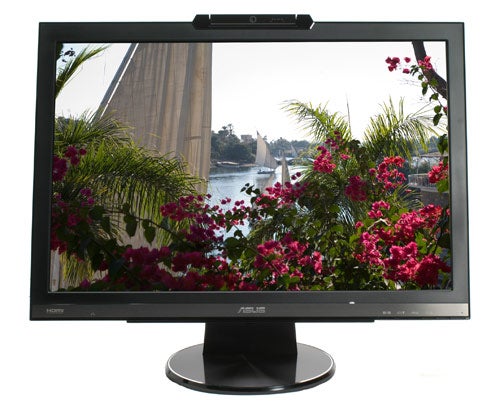
Verdict
Key Specifications
- Review Price: £310.00
Asus has been on a bit of a roll lately, producing some truly impressive and innovative products. The Asus Eee PC for instance was a prime example of the company carving a new niche in the market and opening up a whole new price point for mobile computing. Meanwhile, the Asus branded notebooks have also seen well deserved success over the past year or so, and that situation looks set to continue with some new models just around the corner set to throw up some serious competition for the likes of Sony and Samsung. Unfortunately the product I’m looking at today is going to do little to enhance Asus’ strong reputation.
When Asus showed off the MK241 24in monitor at CES last month, the specs looked very promising indeed. It looked like it was going to be quite a feature rich display, at a potentially bargain price, which is a pretty compelling combination. Asus promised an SRP of $539 in the US, which equated to a very compelling price in the UK working on the current exchange rate – although things rarely work out that way when products actually hit the shores of Blighty. So why hasn’t this screen lived up to its early promise?
Aesthetically there’s little wrong with the MK241, finished in matt black, with a brushed aluminium strip running below the panel. The round base is finished in brushed aluminium too and adds to the sleek and modern style, but looking at the design a bit more closely reveals some major disappointments. First up, there’s no height adjustment – this may be just about acceptable in the 22in market, but on a 24in monitor it’s virtually unforgivable. The lack of height adjustment also rules out pivoting duties, so if you like to be able to switch into portrait mode, you’re going to have to look elsewhere. Even more bizarre is that there is no swivel pad under the base, so you can’t even pan the screen from side to side – something that you’d need to do if you wanted to show a colleague what was on your screen due to the less than impressive viewing angles. The only adjustment at your disposal is forwards and backwards tilting.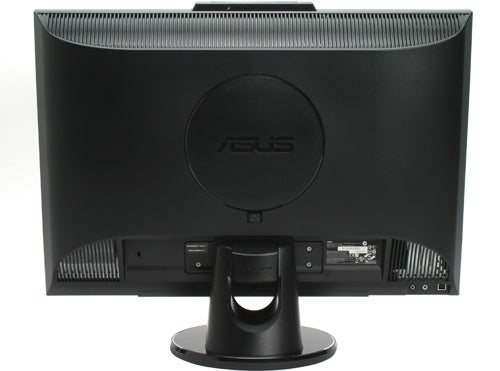
In this screen’s defence, the features do, in part make up for the woeful lack of adjustability. You can connect up to three sources to the MK241 via the DVI, HDMI and D-SUB connections – unfortunately there’s no component input, so Nintendo Wii owners won’t be using this screen for their Super Mario Galaxy fix. Like any good monitor with multiple inputs, there’s a dedicated source select button that toggles through each input.
Talking of buttons, the array of controls located on the bottom right edge of the fascia is well laid out and fairly intuitive. There’s a power button with an obligatory blue indicator light, the aforementioned Source Select, a Menu button, up and down arrows. The final button switches between the preset picture modes – Theatre, Game, Night View, Scenery and Standard. None of them do a particularly great job, with Standard being the best of a bad bunch. Also, pressing the up arrow activates a shortcut to the Brightness setting, while the down arrow shortcuts to the volume setting.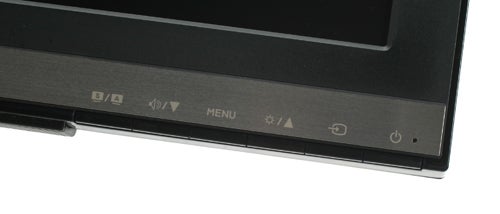
The volume setting gives away the fact that this monitor has built-in speakers, which you can’t really tell from looking at it. Like may of the latest flat screen TVs to hit the market, the MK241 has hidden speakers that don’t spoil the aesthetics. However, there’s often a fear that making speakers unobtrusive can adversely affect sound quality and that’s certainly the case here. You can feed sound to the built-in speakers via a mini-jack line in, or via the HDMI port, but whichever route you choose the result is the same – weak and unpleasant sound with a complete lack of bass. On the plus side, there is a headphone socket underneath the font fascia and a line-out socket at the rear, so you can just pass through the sound and bypass the internal speakers completely. 
Adding to the MK241’s feature list is an integrated webcam mounted at the top of the screen. The webcam can pan 30 degrees up or down, so you should be able to frame yourself easily, despite the lack of height adjustment of the screen itself. Mounted to the right of the webcam are two array microphones, although being that they’re about a centimetre apart, I’m not sure that they can really be classed as an array. That said, there’s a third microphone at the rear of the webcam housing, presumably acting as an ambient sound filter. The upshot of all this is that you’ve got built-in video conferencing hardware, without the need of a clip-on camera or headset. 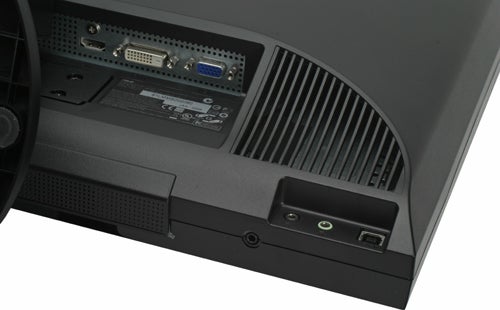
Despite the fact that I’m not a fan of webcams, the unit integrated into the MK241 works very well, and the LifeFrame software that ships with the screen adds a lot of functionality – some useful and some just fun. For instance, you can record videos using the webcam (if you’re into that kind of thing), or just take still images. You can also apply filters, in case you want to mask your appearance – although I can’t help but think that if you want to mask your appearance, why use a webcam in the first place?
So far the Asus MK241 is a mixed bag of poor adjustability tempered by a reasonably strong feature list, leaving image quality as the deciding factor. Unfortunately for Asus though, this is where things fall apart completely, because when it comes to image quality this monitor is woefully disappointing. Things start off bad with incredibly oversaturated colours that make even a default Windows Vista wallpaper look radioactive. Yes, this can be toned down with a bit of tweaking, but no amount of fiddling with the User setting produces what I would call an acceptable colour palette. A lot of mucking about with the brightness and contrast settings managed to reign things in a little too, but on the whole this screen’s claims of high colour gamut produce a reality that it far from pleasing to the eye.
A result of the oversaturated colours is that detail is lost at the high intensity level, with serious compression evident. I didn’t even have to fire up DisplayMate to see this problem, as simply viewing photographs in Photoshop CS3 showed that areas of highlight were completely blown out with this screen. Also, if I tried to counteract this by dialling the screen back a bit, the result was a loss of detail at the low intensity end, which was already suffering from its own problems.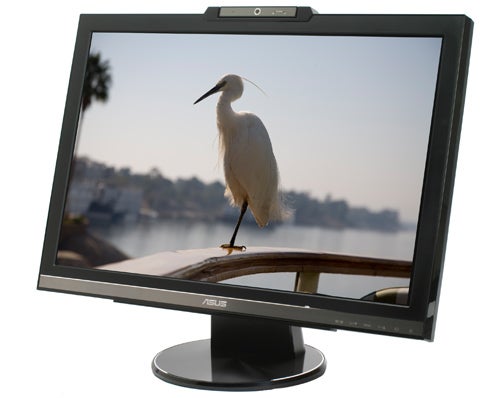
Talking of problems at the low intensity end, this screen has the worst black level response that I’ve seen in quite some time. First up there is an excessive amount of light bleed evident along the top and bottom, as well as both edges of the screen, but this is only part of the problem. Blacks don’t just look grey, as they do on many mediocre LCD displays, they actually have a brown tinge to them. This means that if you’re watching a movie, the black bars above or below the widescreen image are actually a dirty brown colour.
The poor black levels are highlighted by one of this monitor’s best features – 1:1 pixel mapping. Many monitors have a 1:1 setting in their OSD, but the vast majority of them don’t actually work. Therefore Asus should be congratulated for having a 1:1 implementation that works perfectly. When I connected a Toshiba HD-XE1 HD DVD player to the MK241 and output a 1080p signal, the resulting image showed thin bars top and bottom, since the screen’s native resolution is 1,920 x 1,200 and the incoming signal was 1,920 x 1,080. However, when I played a film I was presented with those dirty brown bars above and below the action, while at the very top and bottom were two thinner bars of a completely different colour. Unfortunately the thin bars at the top and bottom weren’t actually black either due to the excessive light bleed!
Putting the black levels to one side, you still wouldn’t want to watch movies on this screen. The skin tones are simply horrible with actors looking distinctly ill in most scenes, while the quoted 2ms response time does little to keep that old LCD bugbear of motion smearing in check. Add to this the fact that all these problems are exacerbated when you’re watching standard definition content and it’s clear that this screen doesn’t live up to its movie watching promise. Bizarrely the MK241 actually has specific skin tone settings, but the setting is switched off in the OSD when connected via DVI or HDMI – the two connections that you’re most likely to need that setting for.
Games fared slightly better on the MK241, with Burnout Paradise on the PlayStation 3 looking bright, vivid and sumptuous. That’s not to say you’ll be blown away when you fire up your favourite game, because that old black level problem still remains. Play something that’s far darker and gloomier than Burnout, like Gears of War, and you’re left with everything looking brown and dirty, rather than black and sinister. You’ll also be limited to single player gaming, since the poor viewing angles make it difficult for more than one player to get a good view.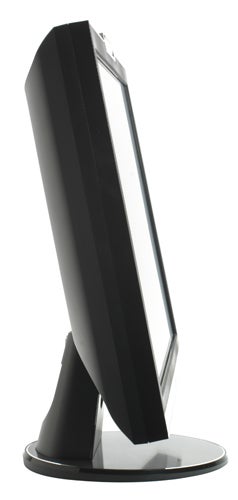
Asus claims that the MK241 has a wide colour gamut equating to 92 per cent of the NTSC colour space. Unfortunately that hasn’t resulted in a colour palette that’s in any way pleasing. The contrast ratio is quoted at 3000:1, which incorporates dynamic backlighting, but considering the disappointing black level response, this simple isn’t working, while the aforementioned light bleed just adds to the problem. Brightness of 450cd/m2 is what you’d expect from a 24in display, while I’m assuming that Asus’ quoted 16.7 million colours comes from improved dithering techniques, since this is a 6-bit panel.
Because this is a very early sample of the MK241, there are no retailers stocking it yet, but Asus has quoted me an SRP of £310 including VAT. That’s a pretty good price considering it’s an SRP, and once retailers do pick this screen up, you can expect the street price to drop below £300 quite quickly. That said, the Samsung 245B that I looked at back in August 2007 can already be had online for around £285, and although it lacks some of the features that the MK241 has, it provides better image quality and far more adjustability.
”’Verdict”’
The problem with the MK241 is that Asus seemed to be torn about where to position it. It’s a monitor that has an impressive list of connection options, audio pass through from HDMI and line-in, with line-out and a headphone socket, plus a built-in webcam. But all this functionality is coupled with a woeful lack of screen adjustability and very dubious image quality. On paper this screen looks like good value, but I’d be happy to lose one of the inputs and the webcam in favour of a better image and some height adjustment.
Trusted Score
Score in detail
-
Image Quality 5
-
Value 8

